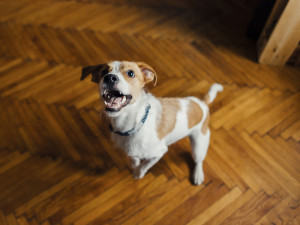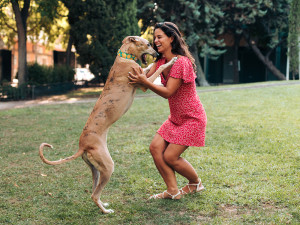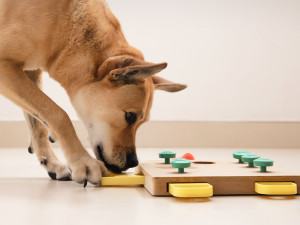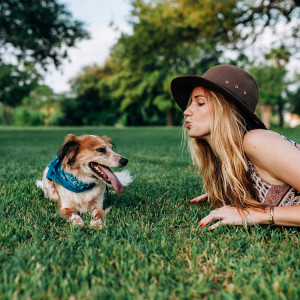How to Fix Your Dog’s Non-Stop Barking
You can live in a quiet house again.
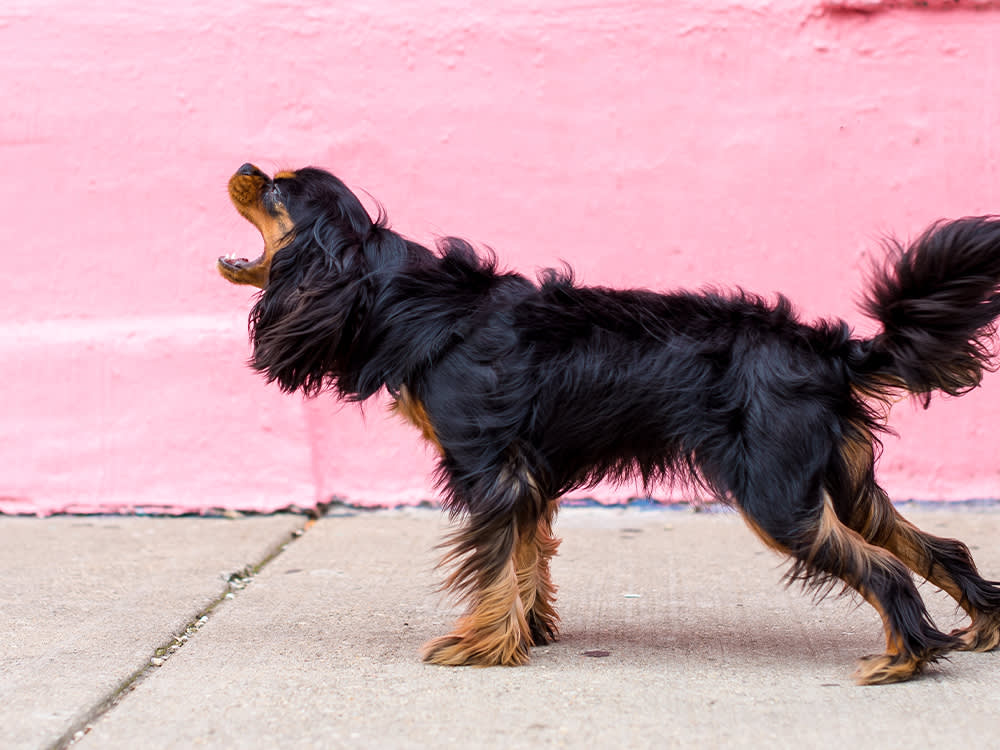
Share Article
Of all the mysterious things dogs do — feverishly digging to who-knows-where, gleefully shredding cardboard boxes instead of playing with toys — barking is one of the trickiest behaviors to decode. And that’s a problem, because it’s not only irritating; it can also be an indication that something is not quite right with your pal.
So, if you find that your dog is becoming especially vocal, here’s what you do: keep a bark diary. Yes, a bark diary. This is simply a journal where you keep track of each time your dog barks and what seems to have caused the commotion. Also note your dog’s body language at the time — ears perked up or held back, tail stiff or tucked between their legs? Once you connect the dots, you can better train them to go on mute. Below, how to stop your dog from barking in every scenario.
Alert Barking
If your pup starts yapping when the mail carrier shows up or someone walks past your house, that’s probably alert-barking, which is pretty common. You can unintentionally reinforce this behavior just by going about your business. As far as your dog is concerned, their barking may have been the scare tactic that successfully kept your home safe from an intruder.
Get a head start on breaking the habit by blocking visibility when you’re not actively in training mode. Then, set up training sessions where you mark and treat your dog when they sit quietly while people pass by. You may have to start with an obscene number of treats, doling them out as each person passes, but once your dog catches on, you’ll be able to reel it back in.

Reactivity
Does your dog lunge and bark like a hellhound when other dogs or people walk past? That’s called reactivity, and it’s brought on by fear, over-excitement, or frustration. You can help in this department by keeping your pup “under threshold,” meaning giving them plenty of distance from triggers so they can keep their cool. Then, pull a mark-and-treat routine on them to redirect their focus from the trigger back to you. They can still look around, but get them comfortable enough to check in with you regularly. Remember that not all triggers are created equal — a dog walking toward you may grind your pet’s gears more than one walking away, so be observant and change your approach accordingly.
Separation Anxiety
When a dog starts barking up a storm the second you leave — and keeps it up until you return — you’ve got separation anxiety on your hands. This is a panic disorder and, to them, your departure is on par with getting lost at the grocery store as a kid. Milder cases of separation anxiety may just involve some barking and pacing, but in more extreme ones, dogs can damage property or even injure themselves while trying to escape your home to find you. Again, keeping your dog “under threshold” can help. In this case, that means not leaving them alone for longer than they’re comfortable — at first.
Start practicing short departures: walking to the front door, opening and closing it, then going back to your dog and treating them. The next step is walking out the door, closing it behind you, then returning and treating. Keep an eye on their body language and shorten the time you’re away if you pick up on distress signals. Baby steps. When you’re not around, a stuffed Kong can keep your pup distracted, CBD can calm them down, and a video monitor can monitor their stress levels. If your dog’s separation anxiety stays at fever pitch, consider consulting with your vet about anti-anxiety medication (but only after you’ve exhausted all training options).
Demand Barking
When your dog barks at you when you’re not paying attention to them or when they’re ready for their dinner, they’re making demands. As tempting as it may be to give in to make it stop, doing so will only reinforce (and exacerbate) this behavior. Try curbing this habit by increasing your dog’s daily enrichment, engaging both their brain and body with puzzle toys, training sessions, and long walks so they’ll burn energy and won’t bug you.
If you pay attention to changes in their body language, you can spot (and stop) barking before it starts. If you miss a cue, don’t scold your dog — that’s still acknowledging the behavior. Instead, your best weapon is a cold shoulder. You can say a lot by saying nothing at all, and your pup is sure to get the message.
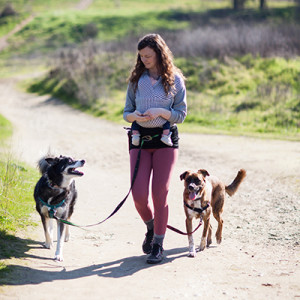
Tressa Fessenden-McKenzie, KPA-CTP
Tressa Fessenden-McKenzie, KPA Certified Training Partner and Family Paws Parent Educator, is the founder of Path and Paw and a training advocate on Dogly.
Related articles
![woman gives small black dog treat for sitting]()
Your Dog Should Do This 30-Day Training Challenge
It’s like your 30-day yoga challenge — except with way more training treats.
![Boston terrier being stubborn]()
Dog Training — DIY or Hire a Pro?
When it’s time to call in reinforcements.
![Shy black dog walking with owner at the park.]()
How to Help an Anxious Dog Conquer Their Fears
Pro tips for boosting the confidence of a scaredy-cat dog.
How to Manage Leash Reactivity in Your Dog
If your pup acts diabolical on walks, you are not alone. Here’s what you can do.
![A woman playing with her dog making a kiss face at it.]()
How to Avoid a Dog Bite to the Face
Step one: Never put your face close to theirs.
![A dog laying on a couch looking relaxed]()
Is Your Dog Sad?
Or are they just peacefully resting? Behaviorist Karen London explains how to tell the difference.
